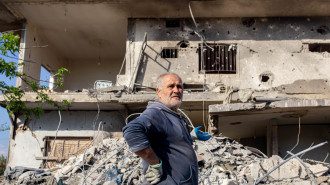Palestinians and Lebanese remember the Sabra and Shatila massacre 42 years on
Forty-two years have passed since the Sabra and Shatila massacres when an estimated 3,500 Palestinian civilians living in Beirut were massacred by a Lebanese militia overseen by the Israeli military.
No one has ever been held accountable for the brutal killings that took place in the two Palestinian refugee camps in Beirut between 16 to 18 September 1982 and have added further strain on the families of the victims who commemorate the killings every year.
Ahmad Al-Ghadban, 14, was born in Shatila and his grandfather survived the massacres, which was one of the single bloodiest events in the Lebanese civil war.
"He told me the Israeli army entered Lebanon, occupied Beirut, then the (Lebanese fighters) entered the Sabra and Shatila camps and attacked the residents with armed militias," he told Al-Araby Al-Jadeed, The New Arab's Arabic-language sister edition.
Most of those who were adults when the massacres took place 42 years ago have since died with comparisons made to the current massacres taking place in Gaza.
"The massacres in Sabra and Shatila are the same massacre as the one in Gaza now, the agenda is the same. It's a political agenda and the goal is that no Palestinian should be left alive, so no one will remain to defend the land of Palestine," he said.
Prior to the slaughter, Israeli forces had swept through southern Lebanon and laid siege to the Palestinian refugee camps in Beirut where many PLO and other fighters were concentrated.
On 1 September, thousands of Palestinian fighters, led by former Palestine Liberation Organisation leader Yasser Arafat, left for Tunisia and other countries under international protection.
Despite a multinational force having been deployed to protect the Palestinian civilians still in the camps, this force withdrew on 11 September leaving them at the mercy of militias that had fought for years against the PLO.
There was nobody left to defend the civilians, the Israeli military sealed off the entrances to Sabra and Shatila camps, preventing civilians from fleeing, as the Phalange - a right-wing Lebanese Christian militia - carried out massacres over three days, killing defenceless children, women, and elderly, predominantly Palestinian but also some Lebanese.
Many families were wiped out completely. In others, one or two family members survived by hiding on rooftops, in cupboards, or behind kitchen sinks. Hundreds of children watched their families slaughtered in front of their eyes.
Today, Sabra has changed beyond recognition, and Palestinians there are a minority, most having sold their homes and emigrated.
Meanwhile, the population at the Palestinian refugee camps has become mixed with other nationalities - predominantly Syrians and Lebanese - but even after all these years, the residents have not forgotten the massacres.
Mohammad Bahar lives in Shatila camp, his family originally from the town of Saffuriya in present-day Israel, said the massacres were intended to "kill as many people as possible in the camps to stamp out such a thing as resistance and to end the idea of a resistance force seeking to defend the land".
"The enemy couldn't achieve its goal of eliminating the camps' residents, we are a people of resistance," he said.
"Our people returned to the camp after the massacre, and breathed life into it again, rebuilding the homes the attackers burned."
Bahar points to the resilience of the Shatila residents, how they moved back, married, and had families, with some of their children going on to become resistance fighters.
"Today the camp is home to a mix of people, including some original camp residents," he said.
"There are also Lebanese here who can't afford to live outside the camp any longer due to the cost of living. Life in the camp is cheaper than outside, and there are also Syrians who were displaced by the war."
The descendants of those who lived in Shatila at the time of the massacre have inherited the harrowing stories of their forefathers and mothers, and continue to pass them down through the generations so that these memories will not be forgotten.
In their view, Israel wants to kill every Palestinian, especially the children, so that no one will remain to try to regain or defend their homeland.
Today, Shatila's walls are full of defiant slogans and posters praising the resistance and calling for people not to abandon the "gun".
The camp is brimming with people, the constant hum of activity and the love for life of its residents showing they still retain the hope of returning to Palestine.
Shatila resident Muayyad Aqil, whose family is from Tiberias, has heard stories of those fateful days passed down from "the elders".
"Some families have disappeared completely, leaving no trace, just as is happening now in Gaza in the genocide the enemy is committing with the most advanced weapons," Aqil said.
"The message is clear: they don't want any Palestinian left alive – they want to kill us and eradicate us from existence."
This article is based on an article which appeared in our Arabic edition by Intisar al-Danan on 16 September 2024. To read the original article click here.





 Follow the Middle East's top stories in English at The New Arab on Google News
Follow the Middle East's top stories in English at The New Arab on Google News

![MP Essam Diab's pursuit to block TikTok in Egypt has revived an already ongoing debate in the country. [Getty]](/sites/default/files/styles/image_330x185/public/1230748046.jpeg?h=a5f2f23a&itok=-8MqBLLC)
